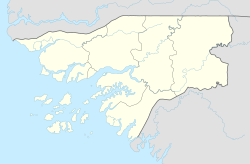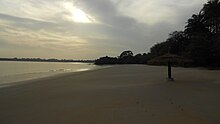Bubaque (sector)
| Bubaque | ||
|---|---|---|
|
|
||
| Coordinates | 11 ° 17 ′ N , 15 ° 50 ′ W | |
| Basic data | ||
| Country | Guinea-Bissau | |
| Sul | ||
| region | Bolama | |
| ISO 3166-2 | GW-BL | |
| surface | 1,013.3 km² | |
| Residents | 17,356 (2009) | |
| density | 17.1 Ew. / km² | |
Bubaque is an administrative sector of Guinea-Bissau . It has an area of 1013 km² and 11,204 inhabitants (as of 2009).
The sector is in the Bissagos Islands , since 1996 registered biosphere reserve of UNESCO . It consists of a series of islands with the eponymous main island Bubaque .
In the traditionally matriarchal society, women are still often the decisive head of the family. The society of the local Bijagos people is animistic belief and strongly committed to traditional traditions.
Culture and sights

Bubaque is the most touristic island of the Bissagos Archipelago. Tourism is still developing here, but there are already hotels and an offer for nature and culture enthusiasts.
The Museu de Bubaque “Padre Biasutti” , which opened in 2009, houses a comprehensive collection of sculptures, masks and ritual and everyday objects that are traditionally carved out of wood with a knife. The Italian missionary Luigi Scantamburlo, who has lived here since 1975, collected the pieces that are now considered the most important museum of the Bijagos culture . The museum is open every day from Tuesday to Sunday mornings and afternoons.
The best known attraction is the annual festival de Bijagos (also Festival de Bubaque ). Every year on three days of the Easter weekend, music and dance performances can be experienced here, to which many visitors come, especially from the capital and the surrounding areas.
In addition to the Bijagos culture and unspoiled nature, the main attraction for visitors are the white sandy beaches, such as Praia da Bruce on the island of Bubaque, 15 km from the city of Bubaque, or the Ponta Anchaca on the island of Rubane with the hotel complex of the same name.
In the town of Bubaque with its decaying harbor and the adjacent lively market, some colonial buildings can be seen, albeit mostly in poor condition. Particularly noteworthy is the former manor house of the local administrator, in which the municipal sector administration resides today.
Economy and Transport
The livelihood is based on traditional fishing and the harvest of naturally irrigated rice, cashews , peanuts and the like. a.
Tourism is slowly becoming a factor. Nature and culture lovers in particular are increasingly discovering the island and the Bissagos archipelago as a whole, even if only to a relatively small extent so far.
The sector has Bubaque Airport with the IATA airport code BQE and the ICAO code GGBU. Above all air taxis and private planes from mainland Guinea-Bissau, but also from Cap Skirring in nearby Senegal land here.
There is a regular ferry connection from the port of Bubaque to the capital Bissau.
There is only one paved road in the Bubaque sector, an 18 km long path on the island of Bubaque. German entrepreneurs had built a palm oil factory in the town of Bubaque in the early 20th century and built this road as well.
structure
The Bubaque sector consists of eight permanently inhabited islands:
- Bubaque (main island)
- Canhabaque
- Ganogo
- João Vieira
- Menegue
- Orangozinho
- Soga (Guinea-Bissau)
- Rubans
Then there are uninhabited islands and islets.
Until 2004, other islands belonged to the Bubaque sector, in particular Orango and Canogo . Since 2004 they have belonged to the then newly created UN sector .
Parish partnership
Web links
- Festival de Bubaque website (English, French and Portuguese)
Individual evidence
- ↑ Annual Statistical Report Guinea-Bissau 2015 (p. 10), PDF available from the National Statistics Office INE on January 4, 2018
- ↑ Inhabitants by region, sector and town by gender, 2009 census (p. 58, port.), PDF retrieval from the National Statistics Office INE of January 4, 2018
- ↑ Joana Petrolho, Marta Rosa: À Descoberta da Guiné-Bissau . , Afectos com Letras / EU, Pombal 2015, ISBN 978-989-20-6252-5 , p. 129
- ↑ Joana Petrolho, Marta Rosa: À Descoberta da Guiné-Bissau. , Afectos com Letras / EU, Pombal 2015, ISBN 978-989-20-6252-5 , p. 114
- ↑ a b Website of the Festival de Bubaque (English, French and Portuguese), accessed on January 4, 2018
- ↑ Joana Petrolho, Marta Rosa: À Descoberta da Guiné-Bissau. , Afectos com Letras / EU, Pombal 2015, ISBN 978-989-20-6252-5 , p. 118
- ↑ a b Joana Petrolho, Marta Rosa: À Descoberta da Guiné-Bissau. , Afectos com Letras / EU, Pombal 2015, ISBN 978-989-20-6252-5 , p. 112ff
- ↑ Overview of the town twinning of Cascais , umbrella organization of the Portuguese district administrations ANMP, accessed on January 5, 2018


